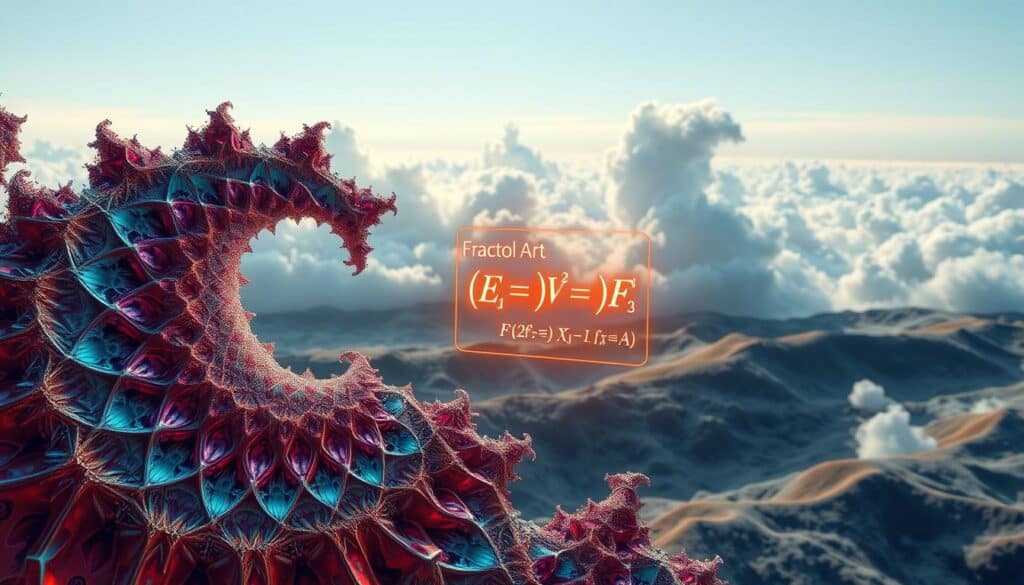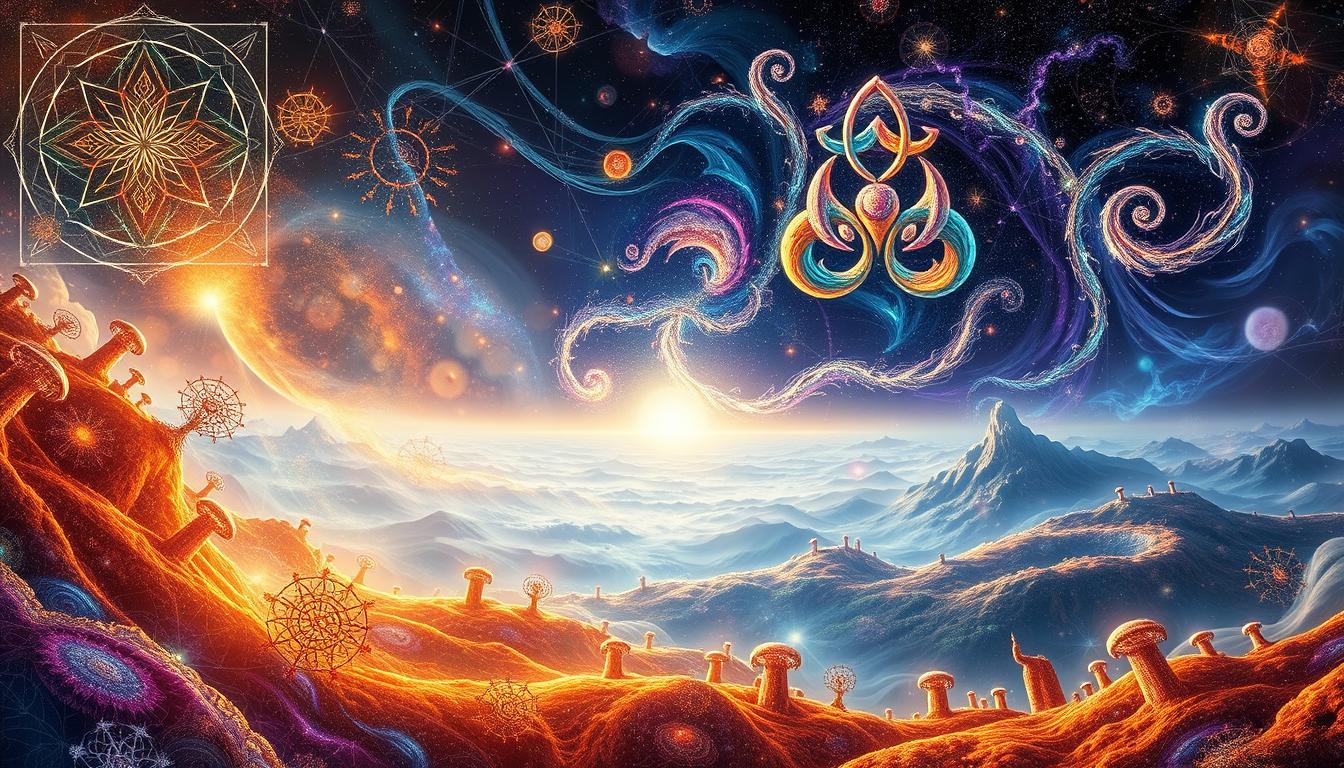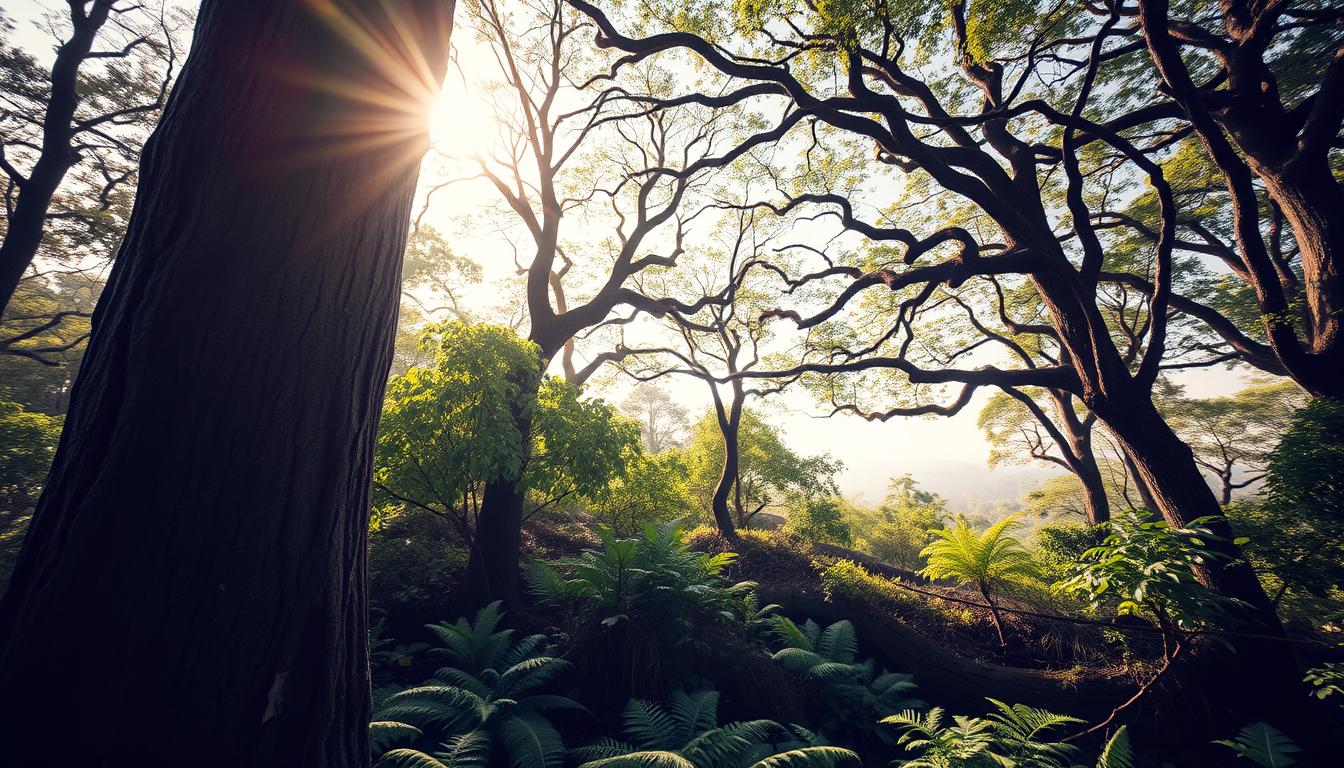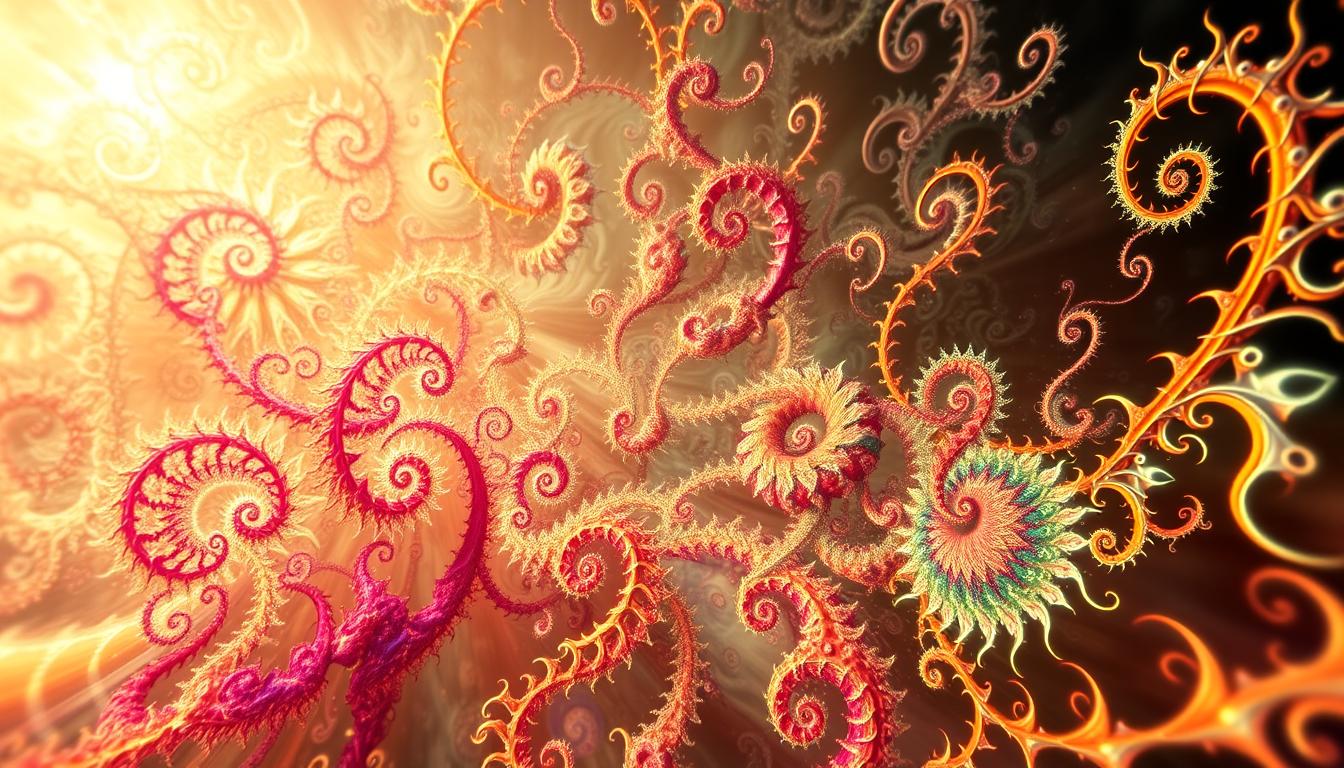Fractal art is a unique blend of culture, math, nature, and artistry. It uses patterns and shapes to mirror human experiences. Through these designs, it tells new stories about our culture.
Fractals in art do more than just look nice. They dive deep into spirituality and tradition, connecting the past with the present. By combining old techniques with new tech, digital fractals introduce fresh, creative ideas. These ideas speak to people from different cultures worldwide.
Understanding Fractal Art
Fractal art is all about creating complex geometric shapes that repeat patterns at different sizes. It is a type of art that uses math to make intricate designs that catch the eye. By using these math rules, artists mix chaos and order in their work.
The Mandelbrot set and Julia sets are important examples in the fractal world. They show the variety and beauty in fractals. These fractals are known for repeating shapes, detailed designs, and sometimes surprisingly beautiful outcomes that are like patterns in nature.

The beauty of fractal art comes from mixing simple and complex ideas. It takes viewers on a journey where math and art meet perfectly. This makes it both fascinating and beautiful to look at.
The Intersection of Art and Mathematics
Art and math may seem worlds apart. But they share a story of creativity and structure. Math’s role in art opens a special language far from ordinary art expressions. Fractals bring this to light, showing complex patterns from easy math rules.
Fractals blend with creativity to make amazing visuals. These structures are infinitely complex yet repeatedly similar. This quality makes them both fascinating and deep. Artists are using fractals more, pushing the limits of what they can make.
Fractals make math’s abstract ideas visible and beautiful. This brings together math’s hard concepts and the beauty we can see. It makes both art and math more enjoyable for everyone.
Fractals in Ancient Art and Sacred Symbolism
Ancient art shows deep ties between creativity and spirituality through complex patterns. Many societies used fractal-like motifs in their art and buildings long before we knew what fractals were. Their works often show sacred geometry, mixing math precision with beauty.
In Hinduism and Buddhism, sacred geometry shines in mandalas. These circles are spiritual icons, showing the universe and paths to enlightenment. The repeating patterns in mandalas highlight the belief in life’s cycles.
African tribal art uses fractals to express community ties and nature connections. Geometric patterns tell stories, beliefs, and connect to ancestors. They create a compelling story of community and life’s flow.
Celtic knotwork is another example, with its intertwined designs that mean eternity and connection. Every curve and loop shows a strong cultural sense of the infinite. It invites us to see how physical and spiritual worlds are linked.
Fractal Patterns in Cultural Diversity
Fractal art shows how cultures blend art and diversity. These patterns repeat in many societies, showing their unique views. African textile designs often display these fractals, mixing tradition with new influences.
Buildings also reflect fractal geometry in art worldwide. Indian temples and Japanese gardens use fractals in different ways, telling their cultural stories. Experts in ethnomathematics find that fractals are common in many cultures. These patterns help us appreciate our collective art history and the unique customs of each community.
Fractal Art and Technological Evolution
The journey of fractal art has been significantly shaped by tech advancements. In the 20th century, the discovery of fractal mathematics allowed artists to explore creativity in new ways. The arrival of computers and advanced software let them dive into digital fractals. This broke the rules of old-school art.
This mix of tech and art has opened up new paths for creators. Artists can now:
- Generate intricate images that were once inconceivable.
- Utilize algorithms to create dynamic and interactive works.
- Disseminate their art through various digital platforms, reaching global audiences.
As fractal art keeps evolving, the blend of creativity and tech promises more groundbreaking expression. Now, emerging artists can blend their ideas with potent tools. This ensures fractal art stays at the edge of modern art movements.
The Digital Revolution and Fractal Art
The digital revolution has changed art, especially fractal art. Artists now use advanced tech to make complex, colorful images. This change is clear in computer-made fractals, where math creates amazing visuals. Artists like Scott Draves and Julius Horsthuis have used art that generates itself to show what fractals can do.
These creations don’t just show off math’s beauty. They also make people feel a sense of wonder, like mindfulness does. The repeating patterns in fractal art are like modern meditation. They remind us of old spiritual practices tied to cultural and religious symbols.
Fractals are now a way to connect science and art, thanks to the digital revolution. Adding technology to art has made creativity richer. It makes people think deeply and enjoy the beauty of shapes and complexity.
The Significance of Fractal Art in Cultural Expression
Fractal art plays a big part in how we see and connect with art. It combines nature, math, and spirituality in a special way. By using fractals, artists tell stories about where they come from and what they believe.
Artists use fractal patterns to show life’s complexity. These patterns show how culture moves and changes. Fractal art helps tell stories about people and their lives.
Through fractal art, we can look into big ideas like how everything is connected. It shows us different cultures in a new light. This kind of art helps us see the value in other people’s stories.
Fractals in Contemporary Artistic Landscapes
Today’s artists blend fractals into modern designs, showing the complexity of our lives. This mix highlights how technology and digital culture shape society. Fractals appear in various forms, such as paintings, sculptures, and digital art.
Artists include historical and cultural themes in their work, connecting with today’s viewers. Fractals serve as a visual language for identity, social issues, and human experiences. They bring out feelings of chaos and order, showing the contrasts in our life.
One key trend is generative art, which uses algorithms to create art similar to natural fractals. It makes us think about creativity’s limits in human and machine-made art. Artists in this field use fractals to innovate and blend traditional and digital art.
Fractals play a big role in the work of current artists, helping to express our world’s complexity. They promise to inspire future artists. This will keep the conversation going about art’s role in understanding our complex lives.
Fractal Art from a Psychological Perspective
Fractals are more than just pretty to look at. They have a big impact on mental health. Many studies have shown that looking at fractal patterns can lessen stress and clear the mind. It turns out that seeing these complex shapes can change how our brains work in a good way. This can make us emotionally stronger.
How Fractals Influence Well-Being
Fractals have an interesting effect on our minds. They can make us feel more calm and relaxed. When we see their intricate designs, it’s like our mind goes into a peaceful state. This calmness helps us focus better and think clearer. By adding fractal art to where we live or work, we make our space better for our emotions.
The Connection Between Nature and Fractal Patterns
Fractals are closely linked to nature because they look like things we see outside, like leaves and mountains. This link shows why nature-inspired fractal art is good for our feelings. By including these natural designs in art and our lives, we remember the world’s beauty. This helps us enjoy nature more and boosts our mood.
Fractal Art in Architecture and Design
Fractals in architecture are becoming more popular among designers. They like to add natural world elements to their work. This method is in line with biomimetic design principles, aiming to mimic nature’s forms and functions. Famous architects like Antoni Gaudí have led this trend, making buildings with curves and patterns from nature.
Today’s architects use fractal modeling on computers to create new and exciting spaces. Fractals make architecture look stunning and blend well with the environment. Nature-inspired designs not only look good but can also make buildings work better and be more sustainable.
Influential Fractal Artists and Their Works
Fractal art is popular today because of artists like Scott Draves and Janet Parke. They’ve really changed how we see this art style. Their ideas have moved generative art forward in big ways.
Scott Draves and Generative Art
Scott Draves is known for starting generative art. He made the Electric Sheep project, where people worldwide make unique art together. Draves shows us how tech can boost creativity, blending fractals and teamwork.
His ideas have changed digital art, creating a lively area for fractals. This place thrives on people working together.
Janet Parke’s Contributions to Fractal Art
Janet Parke has been key in making fractal art well-known. Her detailed work and community support have revealed fractals’ deep beauty and ideas. Parke’s exhibits and teaching highlight math’s appeal in art.
She argues well for fractals as true art. Her influence shows the tight link between math and art.
Conclusion
Fractal art is important for its deep cultural value and ability to express complex ideas. It shows patterns that connect with beauty, connection, and identity in different cultures. This art links math and creativity, using both ancient symbols and modern digital tools.
Looking ahead, fractal art could help us understand cultural stories better. Artists and tech experts should keep exploring these patterns. This will make our world richer and highlight what we have in common. It keeps fractals important in art as culture changes.
Fractal art stands where technology, creativity, and culture meet. It makes us think and encourages curiosity about what’s possible. The future of fractal art is exciting, full of new ideas and ways to connect. It invites us to explore its fascinating world.



